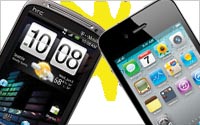electronics
Apple Continues To Have Brand Cachet
- by Aaron Baar , January 22, 2013

Whether it’s the intuitive ease-of-use, the availability of older (and cheaper) devices or just pure brand cachet, the allure of the iPhone continues to keep its grip on the U.S. smartphone consumer.
According to data released by Kantar Worldpanel ComTech, Apple’s iOS-powered devices remained the country’s top-selling smartphone platform for the 12-week period ending Dec. 23. The devices had a 51.2% market share for the period, compared with Android-powered phones’ 44.8%. Meanwhile, Windows-operated phones accounted for a 2.6% market share.
Apple’s attraction spread across various types of phone buyers, snagging both Apple loyalists looking to upgrade to the new iPhone 5 (35%) and those upgrading from feature (i.e., basic) phones to smartphones (30%) who wanted to partake in Apple’s brand cachet, says Kantar analyst Mary-Ann Parlato. And as new iPhones have come out, older versions can be had for less cost, making it easier to buy in for those who are upgrading.
advertisement
advertisement
“You’ve got that brand equity with Apple. We’ve seen that loyalty remains high for their smartphone,” Parlato tells Marketing Daily. “A lot of these people are moving up to an Apple for the first time, and first-time smartphone buyers would like to spend less on their purchase.”
At the same time, Apple is also able to entice other smartphone users. According to the data, 19% of iOS sales over the past year came from Android users, compared to 9% in 2011, Parlato says. This trend was most prevalent among Verizon customers, where nearly half (49%) of the iOS sales came from users of other smartphone brands. (Comparatively, at AT&T only 15% of iOS buyers came from other smartphone users.)
This trend is most evident within Verizon customers, where half (49%) of iOS sales were derived from users of other smartphone brands, and 30% were derived from Android. These figures are much higher compared to AT&T where 15% of iPhone purchasers came from other smartphone users (6% from Android).
Fittingly, AT&T was the market leader among smartphones sold, accounting for a third of the total devices sold in the 12-week period. (However, the company’s market share decreased slightly, and Verizon accounted for 32% of the phones sold during the time frame.) Sprint accounted for only 14.8% of the smartphones sold during the time period.
“AT&T continued to utilize their large Apple[-owning] base with 55% of their iOS sales stemming from these users upgrading to a newer iPhone, while 37% of Verizon’s iOS sales were derived from their large feature phone base,” Parlato says.
Despite the small market share, things might not be entirely lost for Microsoft and its Windows Mobile operating system. Though the 2.6% market share for the period is small, Parlato notes that the company is tied very closely to Nokia, which is a relatively small handset provider in the U.S. (In Europe, where Nokia is more established, Microsoft’s market share is higher, she says.) Should other, more popular handset makers (such as LG, which has been rumored to be developing a Windows-powered smartphone) begin making Microsoft-powered smartphones, the company’s market share could rise.
“I’m interested to see whether other [companies] will pick up Windows and will help it,” Parlato says. “If it remains [embedded among primarily] HTC and Nokia, it’s not going to do as well.”




